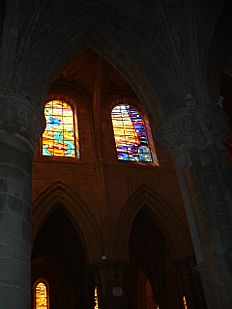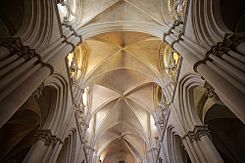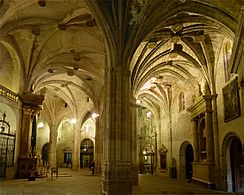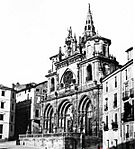Cuenca Cathedral facts for kids
Quick facts for kids Cuenca CathedralCatedral de Santa María y San Julián de Cuenca |
|
|---|---|

Facade of the cathedral
|
|
| Religion | |
| Affiliation | Roman Catholic Church |
| Location | |
| Location | Cuenca, Spain |
| Architecture | |
| Architectural type | Church |
| Architectural style | Norman, Gothic, Romanesque, neo-Gothic |
The Cuenca Cathedral is a beautiful old church in the city of Cuenca, Spain. It's located in the Province of Cuenca in central Spain. This cathedral is one of the very first buildings in Spain to be built in the Gothic style. This was a time when the older Romanesque style was still very popular in Spain.
The cathedral shows a lot of influence from Norman and Anglo-Norman designs from the 1100s. Famous churches like Soissons Cathedral and Notre-Dame in Paris are good examples of this style.
Building work started in 1196 and was mostly finished by 1257. But people kept adding to it and fixing it up over many centuries. For example, in the 1400s, the back part of the church (called the chevet) was rebuilt. In the 1600s, a special chapel was added, and the front of the church and its towers were changed.
Sadly, in 1902, a bell tower called the Giraldo collapsed after being hit by lightning. This damaged a lot of the front of the church. It was rebuilt in a newer Gothic style. There are still plans to finish all the repairs when everyone agrees on the best way to do it.
The Cuenca Cathedral is the main church for the Roman Catholic Diocese of Cuenca. It is named after Mary, the mother of Jesus, and Saint Julian of Cuenca. Saint Julian was the second bishop of Cuenca and is the city's patron saint.
Contents
History of Cuenca Cathedral
The city of Cuenca was taken back from its Muslim rulers by King Alfonso VIII of Castile in 1177. This happened after a long nine-month siege. In 1183, Cuenca became a diocese, which means it got its own bishop. That's when they started building the cathedral. It was built right on the spot where the main Muslim mosque used to be.
Some people say that Eleanor Plantagenet of England inspired the design of Cuenca Cathedral. She was King Alfonso VIII's wife and came from England. Her family's Norman style of building influenced this cathedral. It became one of the first Gothic cathedrals in Spain, along with the one in Avila.
French stonemasons began working on the cathedral between 1182 and 1189. Work continued through the 1200s. The church was officially opened in 1196 by Saint Julian of Cuenca. At that time, only the back part (the chevet) was finished. The main altar was opened in 1208.
As mentioned, on April 13, 1902, the Giraldo tower fell down after a lightning strike. This destroyed a lot of the front of the cathedral and sadly, some children were hurt. The front was rebuilt in a style that looked like old Gothic. There are still plans to fully fix the parts that were destroyed.
What Makes the Cathedral Special?
The Cuenca Cathedral has some features from the older Romanesque style. This is because it started being built when that style was still common. Originally, it had five rounded ends (called apses), a single cross-shaped section (a transept), and three main halls (or naves).
As it developed in the 1200s, new parts were added. These included the upper windows (the clerestory) and round windows (called oculus). You can see the Anglo-Norman influence in the special six-part rib vaulting on the ceilings.
This cathedral is very big! It is 120 meters (about 394 feet) long. Inside, the central area is 36 meters (about 118 feet) high. The whole building covers an area of 10,000 square meters (about 107,639 square feet).
In the 1400s, the eastern end of the church was rebuilt. This created a double walkway around the altar. In the 1600s, a famous architect named Ventura Rodríguez designed the altar of Saint Julian. This altar is known for its beautiful stained glass that lights up the background.
The collapse of the Giraldo tower in 1902 caused a lot of damage. An architect named Vicente Lampérez rebuilt the front of the church. This work was finished in 1910. More recently, the 1500s cloister (a covered walkway) has been fully restored.
Hidden Meanings and Symbols
The artwork and sculptures in Cuenca Cathedral are quite unique. You can find many fantastical creatures and mythological figures. These are mixed in with plants, leaves, and flowing streams. What makes Cuenca Cathedral stand out is its sculptures of animals that were unknown in Europe at the time. These include armadillos, puffer fish, and turtles. These sculptures are found in the Gothic arches from the late 1400s. This was around the time Europeans started exploring the Americas after 1492.
Some people believe there are hidden messages in the cathedral's art. One scholar, Rodrigo de Luz, thought the Holy Grail was kept safe in this cathedral. He believed that because of this, the cathedral and anyone inside would be safe during a final event. He connected the cathedral to descriptions of the "New Jerusalem" from an old book called the Book of Revelation. He pointed to its 12 arch-shaped gates, each with 12 angels. Each stone angel looks serious and holds a book, except for one. This one is smiling and holding a cup. Some think this is a secret hint about the legend of the Holy Grail.
There are also claims of other hidden symbols in the cathedral and the city of Cuenca. For example, the city's coat of arms shows a cup with an eight-pointed star. This star is a symbol sometimes linked to the Knights Templar, a famous group of medieval knights.
Gallery
See also
 In Spanish: Catedral de Cuenca (España) para niños
In Spanish: Catedral de Cuenca (España) para niños






